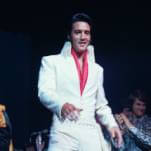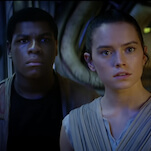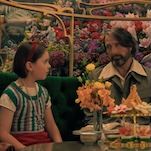For Comics Week, we take a break from our normally scheduled Comics Panel to bring you our favorite second bananas, second stringers, and second fiddles of the comics world.
One of the strangest things to come out of the popularity of the Marvel Cinematic Universe is Marvel’s inability to figure out what to do with James “Rhodey” Rhodes. He got a short post-
Iron Man 2 run that was never canceled, not to mention the recent trauma induced by Bendis and company. For how short it was, Ales Kot and Garry Brown’s five-issue
Iron Patriot (Marvel) was a compelling and fascinating look at what it means to be James Rhodes. Rather than framing Rhodey’s life around Tony Stark, it gave Rhodey an opponent that targeted him personally. Unsurprisingly, given his penchant for political and social commentary, Kot integrated Rhodey’s military service far more seamlessly and deliberately than most writers would have, and the story gets Rhodey’s family up off the bench, giving his genius niece Lila a chance to shine. Rhodey struggles to resist an external force that’s controlling the Iron Patriot suit, a fascinating problem for a black man who is working for the military as a living weapon. Brown’s art is dynamic and interesting, making it even harder to understand why the run was unceremoniously dropped. Rhodey is one of the most underestimated and underused characters in Marvel’s roster, and the trade is well worth picking up. [Caitlin Rosberg]
It’s no surprise that April O’Neil and Casey Jones are often sidelined in the
Teenage Mutant Ninja Turtle comics, but it’s intriguing to see what a talented writer can do with them. In
Teenage Mutant Ninja Turtles: Casey & April (IDW), Mariko Tamaki of
This One Summer fame does just that. She gives the Turtles’ human friends a chance to shine in a story that delivers far more emotion than you might expect. Their opponent gets them isolated from one another while on a road trip, which isn’t particularly hard with two headstrong, capable characters. Though
Casey & April does have the requisite supernatural bad guy and the expected battle, it’s ultimately a story about the relationship between these two characters, the way that they care about and trust one another, focusing on how strong love can make them while making it clear it requires a lot of time and work. Irene Koh’s art and strong colors from Paul Reinwand and Brittany Peer manage to walk the panels back and forth between the softness of fond affection and the horror that doubts can plant between two people thoroughly tangled up in one another’s lives. It’s a short trip for both the readers and the characters, but it’s well worth making. [Caitlin Rosberg]
Originally published in the third issue of DC’s celebrated anthology,
Solo,
“Teenage Sidekick” (DC Comics) is Paul Pope’s argument about the efficacy of Robin. In the 11-page story, Robin is caught alone by a pair of henchmen, bludgeoned over the head, and fed to a wood-chipper by the Joker. Rendered in loud aquamarine and pinkish reds—slabs of color slathered on by the inimitable James Jean—the story is lively and dynamic. Pope’s inks are energetic, and the way he draws Robin twisting his body amid a cacophony of sound effects captures the fun, jovial youth that the author pins to the heart of the character. “Teenage Sidekick” ends with Robin escaping his fate and reconnoitering with Batman to defeat the Joker, who Pope draws as an imitation of Cesar Romero’s version. His hair is mussed and his face is cartoonishly expressive, and he sports facial hair under his pancake make-up. As the omniscient captions attest, this killer is what Batman becomes without Robin. Robin anchors the Dark Knight, makes him whole, and keeps him sane (relatively, at least). Pope’s argument is straightforward, clear, and uncomplicated, but the real appeal is how he illustrates it—with verve, wit, and splendor. [Shea Hennum]
Collecting the first two arcs of the Grant Morrison-written
Batman And Robin,
Batman Reborn (DC Comics) begins Dick Grayson’s short-lived tenure as Batman. Following the simultaneous deaths of Bruce Wayne in the convoluted
Batman R.I.P. and unfairly maligned
Final Crisis, the original Robin takes up the mantle from his mentor, and Damian Wayne is his new Robin. Their contentious dynamic propels the story, which features Grayson trying to provide the Batman role with a sense of continuity.
In the Frank Quitely-drawn “Batman: Reborn,” the first arc of the series and its aesthetic high-point, Grayson and Wayne defend their city from the sadistic Professor Pyg. Diegetically referencing the controversial Killing Joke, Pyg tests the relationship between Grayson and Wayne, and, though he won the right to be the new Batman in battle for the cowl, it is only here that Grayson proves himself competent enough to fill the role. The Philip Tan drawn arc “Revenge Of The Red Hood” continues the series’ meta-story and starts laying the groundwork for Bruce Wayne’s eventual return, but this is a real shame. In “Batman: Reborn,” Morrison demonstrates that Grayson can be rendered as a compelling, interesting, and refreshing Batman—and he should have been allowed a longer tenure in the position. [Shea Hennum]
Although technically Superman never had a sidekick in the same way that Batman did, he still had a place in his heart for one true Pal, in the form of
The Daily Planet’s own cub reporter Jimmy Olsen. Jimmy gets a bad rap, it must be said: He was a dork, yes, but who wouldn’t be a dork if they got to hang out on the reg with the most powerful person on the planet? The first issue of the long-running
Superman’s Pal, Jimmy Olsen, by Otto Binder and Curt Swan, sees Olsen attempting to branch out on his own in three separate stories, to try and solve crimes without any help from his more famous friend. Or rather, perhaps it would be better to say “minimal” help, because Jimmy still as no compunctions about activating his signal watch to call Superman for help when things get too hot.
Jimmy acquits himself fairly well. Many Jimmy Olsen stories emphasized Jimmy’s skill as a master of disguise, and in the course of “The Boy Of 100 Faces,” Olsen successfully impersonates an ice cream man and a door-to-door salesman in order to get the drop on some jewel thieves. He ends up having to call Superman for help after he gets tied to a pier, but otherwise manages to do most of the work of tracking down the crooks and their ill-gotten loot. In “The Case Of The Lumberjack Jinx,” Jimmy impersonates a logger and this time successfully manages to avoid calling Superman for help—Superman arrives on the scene just in time to observe, from a distance, as Jimmy handily solves the “jinx” and gets to the bottom of a case of industrial sabotage. The last story, “The Man Of Steel’s Substitute,” starts with Olsen carrying a cardboard cut-out of Superman and being menaced by a bear, and only gets more weird from there. Jimmy Olsen was a headliner, but had another 16 years of weird, repetitive, and occasionally humiliating adventures to endure before Jack Kirby arrived on the scene in 1970 to shake up the formula. [Tim O’Neil]
Green Arrow has always carried the onus of being the poor man’s Batman, complete with (at various points in his career) an Arrow-Cave, an Arrow-Car, and even a thematically on-brand sidekick in the form of Roy Harper, a.k.a. Speedy. When the attempt was made in 1970 to breath life into both Green Arrow and Green Lantern by combining the two sagging features into one team-up book, creators Denny O’Neil and Neal Adams set out to turn Oliver Queen’s life upside down—and so, famously, his ward Roy Harper became a junkie, shooting up heroin on the cover of
Green Lantern/Green Arrow #85. After riding herd over Hal Jordan for being an intergalactic fascist, Oliver is pulled up short by the revelation that his own sidekick had become an addict right under his nose.
The beauty of the story is that, while many of O’Neil and Adams’ stabs at relevance seem fairly quaint by today’s standards, the idea that Roy Harper got into drugs because his father figure was off gallivanting around the country with Hal Jordan still carries a bite. It cuts to the core of both characters: Green Arrow is a well-meaning leftist who allows his political commitments to overshadow his personal responsibilities, whereas Roy Harper learns the hard way that Oliver Queen is not a man who can be trusted in the same way that, say, Dick Grayson can implicitly trust Bruce Wayne. The relationship between Queen and Harper has never been the same, and has remained contentious—defined by both love and some degree of resentment and distrust—throughout every subsequent iteration, even TV’s Arrow. [Tim O’Neil]
Wally West’s return to the DC Universe has been the catalyst behind DC’s current Rebirth relaunch, and revisiting Wally’s tenure as The Flash reveals why his return is such an exciting development. 1987’s
The Flash, Vol. 2 #1 (DC) has the former Kid Flash taking on the mantle of his late mentor Barry Allen, who sacrificed himself to save the multiverse during Crisis On Infinite Earths, and this debut does great work establishing Wally’s character and how he differs from his predecessor. Written by Mike Baron with art by Butch Guice (back when he was still going by Jackson Guice), the first issue gives Wally a fairly simple challenge—run a replacement heart 2,000 miles to an author awaiting a transplant—but the limitations placed on Wally’s character add tension to the narrative. To start, Wally can only hit a top speed of 750 miles per hour, and his body exerts a huge amount of energy during this process, requiring him to eat gargantuan meals to keep himself moving. His superhero job isn’t easy, and make no mistake, this is a job for Wally. Everyone else involved in the transplant process is getting paid, so why shouldn’t Wally? He demands that the hospital pay for his health insurance in exchange for his services, and putting Wally’s finances front and center heightens the impact of the issue’s final reveal that Wally just won the lottery. It’s a smooth, engaging debut, with a cliffhanger that piques interest for future issues. [Oliver Sava]
Writer Sean McKeever did his best superhero work at Marvel Comics with books like
Sentinel,
Gravity, and
Spider-Man Loves Mary Jane, and after a few years of lackluster projects at DC, he returned to Marvel to bring new depth to an unpopular character: Rikki Barnes, the Bucky of the Heroes Reborn universe.
Nomad: Girl Without A World (Marvel) is a four-issue miniseries cementing Rikki’s place in the main Marvel Universe, teaming McKeever with artist David Baldeon for a story that uses superhero ideas to explore high school power structures. The student council presidential election is the means by which the miniseries’ villain, Professor Power, influences the students to do his bidding, and it allows McKeever to explore the lines between activism and rebellion as the students’ helplessness is used to fuel their righteous anger. The narrative’s emotional foundation comes from Rikki’s friendship with John Barnes, this universe’s version of Rikki’s brother, a complicated relationship that ends in tragedy because that’s what tends to happen to Marvel’s young heroes.
Nomad also includes guest stars like Captain America (Bucky Barnes at the time), Black Widow, Falcon, and the Young Avengers, and Rikki’s interactions with these established heroes inspire her to continue her fight, which she does in the pages of McKeever and Baldeon’s short-lived Young Allies series. [Oliver Sava]








































